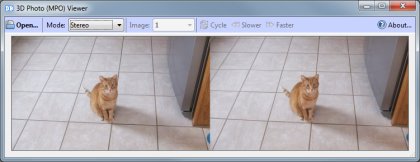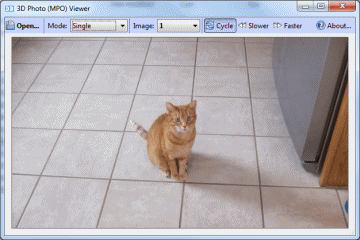A few weeks ago my dad, in his love for electronic gadgetry, purchased a FujiFilm FinePix REAL 3D camera. The concept is pretty simple: it’s basically two cameras in one, with the two sensors spaced as far apart as an average pair of human eyes. The coolest thing about the camera is its LCD display, which achieves autostereoscopy by using a lenticular lens (kind of like those novelty postcards that change from one picture to another when you look at them from different angles), so if it’s held at the right angle and distance from the eyes, the picture on the LCD display actually appears 3-dimensional without special glasses!
Anyway, I immediately started wondering about the file format that the camera uses to record its images (as well as movies, which it also records in 3D). In the case of videos, the camera actually uses the well-known AVI container format, with two synchronized streams of video (one for each eye). In the case of still photos, however, the camera saves files with a .MPO extension, which stands for Multiple Picture Object.
I was expecting a complex new image specification to reverse-engineer, but it turned out to be much simpler than that. A .MPO file is basically two JPG files, one after another, separated only by a few padding zeros (presumably to align the next image on a boundary of 256 bytes?). Technically, if you “open” one of these files in an image editing application, you would actually see the “first” image, because the MPO file looks identical to a regular JPG file at the beginning.
I proceeded to whip up a quick application in C# to view these files (that is, view both of the images in each file). This quick program also has the following features:
- It has a “stereo” mode where it displays both images side by side. Using this feature you can achieve a 3D effect by looking at both images as either a cross-eyed stereogram (cross your eyes until the two images converge, and combine into one) or a relaxed-eye stereogram. You might have to strain your eyes a bit to focus on the combined image, but the effect truly appears 3-dimensional.
- In “single” mode, the program allows you to automatically “cycle” between the two images (a wiggle-gram, if you will), which creates a cheap jittery pseudo-3D effect (see screen shots below).
- Also in “single” mode, the program lets you save each of the frames as an individual JPEG file by right-clicking on the picture.


If you like, you can download the original .MPO file shown in the screenshots above.
Now for a bit of a more technical discussion…. Clearly it would be a great benefit to add support for the .MPO format to DiskDigger, the best file carving application in town.
However, from the perspective of a file carver, how would one differentiate between a .MPO file and a standard .JPG file, since they both have the same header? As it is now, DiskDigger will be able to recover the first frame of the .MPO file, since it believes that it found a .JPG file.
After the standard JPG header, the MPO file continues with a collection of TIFF/EXIF tags that contain meta-information about the image, but none of these tags seem to give a clue that this is one of two images in a stereoscopic picture (at least not the tags within the first sector’s worth of data in the file, which is what we’re really interested in).
One of the EXIF tags gives the model name of the camera, which identifies it as “FinePix REAL 3D W3.” Perhaps we can use the model name (the fact that it contains “3D”) to assume that this must be a .MPO file, but I’d rather not rely on the model name, for obvious reasons, although the FinePix is currently the only model that actually uses this format (to my knowledge).
The other option would be to change the algorithm for JPG carving, so that every time we find a JPG file, we would seek to the end of the JPG image, and check if there’s another JPG image immediately following this one. But then, what if the second JPG image is actually a separate JPG file, and not part of a MPO collection?
For the time being, DiskDigger will in fact use the model name of the camera to decide if it’s a .MPO file or just a regular .JPG file. The caveats of doing this would be:
- It won’t identify .MPO files created by different manufacturers.
- It might give false positive results for .JPG images shot with the camera in 2D mode.
As always, you can download DiskDigger for all your data recovery needs. And if anyone has any better ideas of how to identify .MPO files solely based on TIFF/EXIF tags, I’d love to hear them!
Update: DiskDigger now fully supports recovering .MPO files, based on deep processing of MP tags encoded in the file!